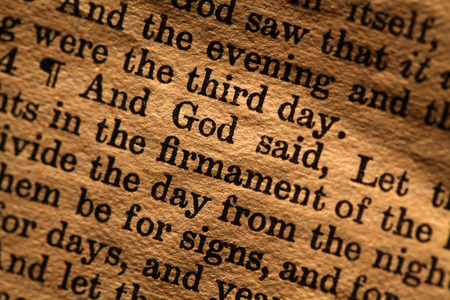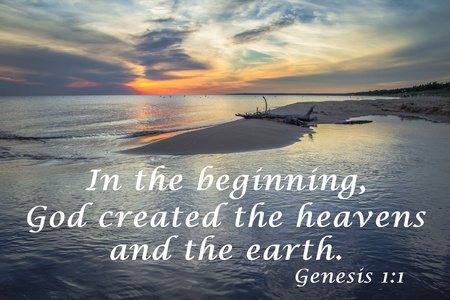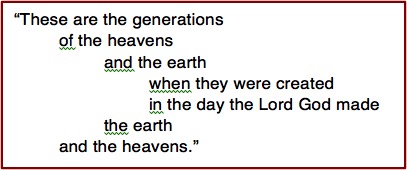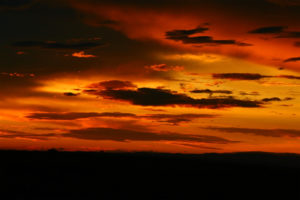In the Beginning, Part 2
Believe it or not, biblical scholars have wandered in the weeds of competing interpretations within the first two verses of Genesis before they even get to the days of creation in verse 3 for hundreds of years; perhaps thousands. The recitation of the days of creation afterwards evokes several additional questions, including the next two. If the six days of creation aren’t 24-hour days, what are they? And what do we make of light created on the first day, when the lights of the heavens, separating the day from the night, are “made” on the fourth day?
Part 1 of this article looked at question of whether there were one or two creation accounts in the first two chapters of Genesis. Following the thought of C. John Collins, we concluded there is one complementary account, with the events of Genesis 2:5-25 happening on the sixth day of creation in chapter 1. But in doing so, we raised the likelihood that the length of the creation week was not an ordinary week. Continuing with the work of C. John Collins in Science and Faith and his commentary, Genesis 1-4, we will explore this possibility and hopefully provide some satisfactory answers to the questions posed above.
The structure of the Genesis 1 creation narrative is well known: six workdays followed by a Sabbath rest on the seventh day. Each of the six workdays begins with “and God said,” and ends with, “and there was evening and there was morning, the nth day.” The King James translation here, “and the evening and the morning were the nth day,” is a mistranslation, seemingly from the Latin version the Bible from the fourth century. The seventh day is different, as God doesn’t “say” anything or “do” anything; and there is no refrain about the evening and morning, as God is resting from all his work.
The creation narrative in Genesis 1:1-2:3 is often referred to as a cosmogony, meaning it is a story about how the universe began. But Collins thinks this is only partly true and in reality, misses the point of the narrative. He sees a cosmogony only in verse 1 (“in the beginning God created the heavens and the earth”), with the narrative then moving on to its main point, “the making and preparing of the earth as a place for humans to live.” If the Genesis cosmogony is only within verse 1:1, then the first creation narrative is silent about the particulars of the creation of the universe.
Additionally, the terms “heavens and earth,” which refer to everything in verse 1, are used with a narrower sense after verse 2. Beginning in verse 8 (and again in verses 9, 14, 15, 17, etc.) “heaven(s)” refers to “sky.” And beginning in verse 11 (and verses 12, 22, 24, 25, etc.) “earth” refers to “land.” Another important fact in support of this interpretation is that the first place the normal Hebrew narrative tense appears is in verse 3, the beginning of the first workday.
This leads Collins to conclude that verses 1-2 are background information to the rest of the narrative. They describe the setting of day one. The typical function of this kind of background statement is to give information on an action that took place at some unspecified time before the narrative about to begin, such as with Genesis 16:1; 21:1; or 24:1.
“All this means that the origin of the whole show gets taken care of in one verse, and the author moves on to focus on something else.” Collins said that the fact that Genesis 1:1-2 is not part of the first day tells us we don’t have to take the creation week as the first “week” of the universe. So however we interpret the days of creation, we are not obligated to read Moses as claiming God began his creative work on the first day of the beginning of the universe or even at the beginning of the earth. “This tells us that some lengths of time don’t matter to the story.” So Collins proposes the following outline for Genesis 1:1-2:3.
| 1:1-2 | Preface: the initial creation event, and conditions as day 1 gets underway.
|
| 1:3-5 | Day 1: light and darkness
|
| 1:6-8 | Day 2: sea and sky
|
| 1:9-13 | Day 3: land, sea and vegetation
|
| 1:14-19 | Day 4: light-bearers in the heavens
|
| 1:20-23 | Day 5: sea animals and flying creatures
|
| 1:24-31 | Day 6: land animals and humans
|
| 2:1-3 | Day 7: God’s Sabbath (no refrain)
|
The passage is a narrative, given its frequent use of the normal Hebrew verb tense for narrative, yet it is has an unusual structure for a narrative genre. The events described within it are unique. There is only one actor—God. And there is a highly patterned (but not truly poetic) way of telling the story. The description of plant life and animals is exceedingly broad. “No single species, other than man, gets its proper Hebrew name.” The sun and the moon in 1:16 are called by unusual names, not otherwise used in the Old Testament. And the term “expanse” in verse 6 seems to be a rhetorically elevated name for the heavens or sky.
The use of phenomenological language in Genesis 1—“describing things by the way they appear, without committing ourselves to be taken ‘literally’”—is also evident in the term “lights” (mã’ôr) used to refer to the sun, moon and stars. The Hebrew word usually means “lamp.” Using this kind of language suited the purposes of the author in a particular way. Its broad stroke, majestic but simplistic, allusive and strictly patterned description “is well-suited to bring out a sense of wonder and delight at the creativity and boundless energy of God.”
All this leads us to conclude that the genre of this pericope is what we may call exalted prose. This name for the genre will serve us in several ways. First, it acknowledges that we are dealing with prose narrative [not poetry], and thus its purposes will be related to other uses of prose narrative—which will include the making of truth claims about the world in which we live. Second, by calling it exalted, we are recognizing that when we come to examine the author’s truth claims, we must not impose a “literalistic” hermeneutic on the text. Further, to call it exalted points us away from ordinary narration and leads us to suppose that its proper function extends well beyond its information to the attitudes it fosters.
God “making” the sun, moon and stars on the fourth day has posed difficulty for readers and interpreters of Scripture throughout history. First, notice how Genesis 1 makes a distinction between light and light-bearing bodies by the creation light on the first day and then “making” or fashioning light-bearing bodies on the fourth. “That is, ‘he made,’ is not the same as ‘he created.’” The Theological Wordbook of the Old Testament commented:
The use of bārāʾ [create] in the opening statement of the account of creation seems to carry the implication that the physical phenomena came into existence at that time and had no previous existence in the form in which they were created by divine fiat. The use of ʿāśâ [made] may simply connote the act of fashioning the objects involved in the whole creative process.
This interpretation means that we don’t have to suppose there was some other source of light besides the sun on the first day; or that the sun, moon and stars appeared on the fourth day as the cloud cover dissipated. “We don’t have to suppose that the days are not in sequence—that day four cannot be after day three (when the plants began to grow).”
Now turn to the refrain, “and there was evening and there was morning, the nth day.” What was “the significance of evening followed by morning in the ancient Hebrew world?” Simply put, nighttime was significant; this was when the worker took his daily rest, as in Psalm 104:22-23. When the sun rises, “man goes out to his work and to his labor until the evening.” So there is a repeated pattern of God working and resting, just as the human creatures who are made in his image. “This daily rest in Israel looks forward to the weekly Sabbath rest.”
Note also there is no refrain on the seventh day, which draws attention to itself by breaking the pattern. If Moses intended to end a first story of creation before introducing a second in Genesis 2:4, we might reasonably expect it, if the days were supposed to be ordinary ones. “Moses wanted us to think that the seventh day had no end—that we are right now living in God’s Sabbath.” The seventh day is then not a 24-hour day.
Turning to the Sabbath commandment in Exodus 20:8-11, we see that God told the Israelites to keep the Sabbath day holy, working six days and resting on the seventh. “The reason is the pattern God set in his creation week: he worked for six days and rested on the seventh.”
Some will say this proves God’s workweek was six ordinary days, since it is a pattern for a human workweek. But Collins noted how this misses two key points. First, the creation rest is unique. Second, “our working and resting cannot be identical to God’s—they are like God’s in some way; but certainly not the same.” Our rest is like God’s because we rest from our labors to contemplate his works.
If we put all of these things together, we see that the best explanation is the one that takes these days as not the ordinary kind; they are instead “God’s workdays.” Our workdays are not identical to them, but analogous. The purpose of the analogy is to set a pattern for the human rhythm of work and rest.
Collins calls this the analogical days interpretation. He claims it accounts for the details of Genesis and for how the rest of the Bible refers to the creation. It provides a tight agreement between the first creation narrative (1:1-2:3) and the second (2:4-25) by showing that the second elaborates just day six. “And if the only price you have to pay for all these benefits is to give up ordinary days—well, that’s not too bad, is it?”
But is Genesis 1:1-2:3 a scientific account of creation? If what is meant by the question, is it true, then yes Genesis 1:1-2:3 is a scientific account of creation. But if we mean: “suited to the purposes for which today’s scientists might want to use the information,” then the answer is no, it is not scientific in that sense. Collins gave the following quote from John Calvin’s commentary on Genesis, to illustrate this distinction. As Calvin reflected on the meaning of verse 1:6, he said: “For, to my mind, this is a certain principle, that nothing is here treated of but the visible form of the world. He who would learn astronomy, and other recondite arts, let him go elsewhere.” Calvin went on to say as he commented on verse 1:16 that Moses wrote in a popular style that all ordinary persons “endued with common sense” were able to understand.
C. John Collins went on to comment if we just say the Genesis account isn’t quite scientific, we haven’t said enough when we’re talking about the Bible and science. “The way Genesis describes God’s work of creation lays a foundation for science and philosophy—for all sound thinking about the world. This is because it tells us that a good and wise God made the world for us to enjoy; and the things in the world have natures that are knowable.”
For more articles on creation in the Bible, see the link “Genesis & Creation.”





